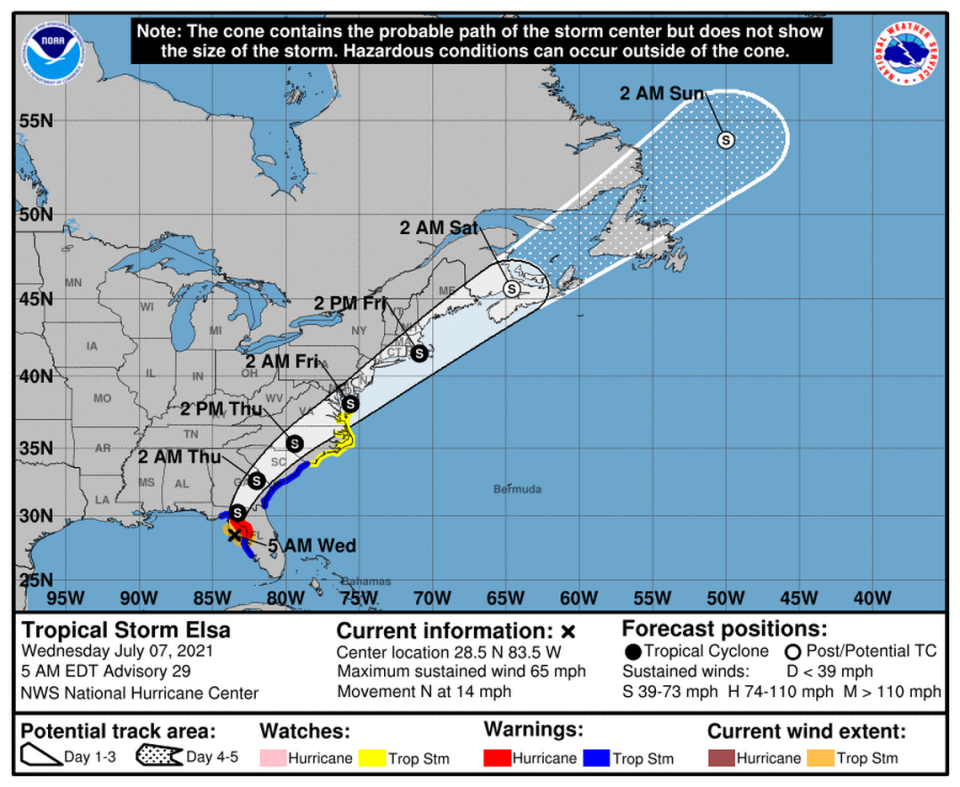Elsa weakens to a tropical storm as it crawls up Florida’s west coast
On Tuesday evening, Tropical Storm Elsa regained Category 1 hurricane status, helped by its daylong journey over the warm waters off Florida’s west coast. Early Wednesday morning, it weakened to a tropical storm.
Despite its status, Elsa already has caused some chaos. After causing widespread property destruction in the eastern Caribbean — including at least three deaths — and flooding agricultural operations in Cuba, Elsa’s impacts in the United States remain to be seen. For Southeast Florida and the Keys, the storm did not amount to much.
The strongest winds were felt in the Lower Keys, where flooding and strong winds were observed, but bars and restaurants on the iconic Duval Street stayed open, despite gusts as high as 70 mph.
“This was a good drill for us,” Monroe County Mayor Michelle Coldiron told county and municipal leaders on an afternoon conference call. “Get some sleep tonight.”
South Florida felt the edge of Elsa’s gusty winds and flooding rains, but it was enough to prompt the National Weather Service to issue a tornado warning for the southern half of the state (minus the Keys) that lasted until 11 p.m.
Elsa’s latest projected path had it passing Bradenton and the Tampa Bay area overnight Tuesday. Storm surge is also likely to be an issue, as the notoriously vulnerable area is predicted to see three to five feet of it.
By 5 a.m. Wednesday, Elsa had 65 mph maximum sustained winds, and its tropical-storm-force winds extended 90 miles from the center, mainly to the east. It was about 50 miles south-southwest of Cedar Key. It was headed north at about 14 mph.

Winds in Tampa Bay, expected to peak overnight with gusts as high as 45 mph, according to the National Weather Service. They should cool down by Wednesday mid-morning.
Bradenton expected similar timing, with high winds starting up Tuesday night, peaking with gusts around 47 mph at 2 a.m. and returning to normal around Wednesday early afternoon.
As of the 5 a.m, Wednesday update, Elsa was predicted to make landfall south of Cedar Key on Wednesday morning.
From there, the storm’s projected path takes it toward the Ocala National Forest, through Georgia and the Carolinas (where it’s expected to weaken to a depression) before emerging in the Atlantic near Virginia Beach late Thursday night.
Potential impacts also remain unchanged with the main threat to south Florida as a whole being heavy rain and a few tornadoes. The threat of tropical storm force winds and minor coastal flooding will remain confined to southwest Florida. #Elsa #SoFla #flwx pic.twitter.com/fs3MgGSnPF
— NWS Miami (@NWSMiami) July 6, 2021
Cuban authorities from the island’s 15 provinces said Tuesday that damages from Elsa were limited to some agricultural areas, particularly in the southern Granma province, where rainfall of about 5 inches flooded some fields and strong winds were reported as the storm skirted the coast.
A local cooperative said that about 3,000 banana trees were downed by Elsa’s gusty winds, which reached about 62 mph in Granma’s coastal regions on Monday. Workers on Tuesday were harvesting what could be recovered to be sold at local markets, according to a report on state news site Cubadebate.
During a meeting led by President Miguel Díaz-Canel, provincial governors said that overall the storm was beneficial to their municipalities as abundant rain replenished reservoirs used for irrigation. Cuba has frequently struggled with droughts in recent years as its aging infrastructure can’t provide enough storage capacity.
Watches and warnings in Florida
A Storm Surge Warning is in effect for:
West coast of Florida from Bonita Beach to the Aucilla River, including Tampa Bay
A Hurricane Warning is in effect for...
West coast of Florida from Chassahowitzka to the Steinhatchee River
A Tropical Storm Warning is in effect for:
West coast of Florida from south of Chassahowitzka to Englewood
West coast of Florida north of the Steinhatchee River to Ochlockonee River
Mouth of St. Marys River, Georgia to Little River Inlet, South Carolina
A Storm Surge Watch is in effect for:
West of the Aucilla River to the Ochlockonee River, Florida
A Tropical Storm Watch is in effect for:
North of Little River Inlet, South Carolina to Chincoteague, Virginia
Pamlico and Albemarle Sounds
Miami Herald staff writers Adriana Brasileiro and Gwen Filosa contributed to this article.

